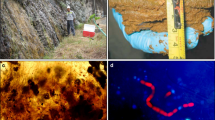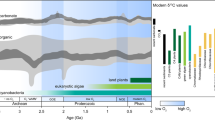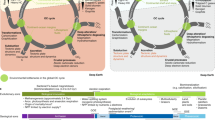Abstract
BIOLOGICAL carbon fixation is an important part of global carbon cycling and ecology. Fixation that took place 3,500 million years ago is recorded in the laminated sedimentary rock structures known as stromatolites, which are fossilized remains of microbial mat communities1–4. Stromatolites are the most abundant type of fossil found in the Proterozoic (2,500 to 590 Myr ago), but they then declined, possibly because of predation and competition5,6. Using modern microbial mats as analogues for ancient stromatolites, we show that the rate of carbon fixation is higher at the greater levels of atmospheric CO2 that were probably present in the past7. We suggest that carbon fixation in microbial mats was not carbon-limited during the early Precambrian, but became carbon-limited as the supply of inorganic carbon decreased8. Carbon limitation led to a lower rate of carbon fixation, especially towards the end of the Precambrian. Thus, another reason for the decline of the stromatolites could have been a decrease in available CO2.
This is a preview of subscription content, access via your institution
Access options
Subscribe to this journal
Receive 51 print issues and online access
$199.00 per year
only $3.90 per issue
Buy this article
- Purchase on Springer Link
- Instant access to full article PDF
Prices may be subject to local taxes which are calculated during checkout
Similar content being viewed by others
References
Schopf, J. W. & Packer, B. M. Science 237, 70–73 (1987).
Schidlowski, M. Nature 333, 313–318 (1988).
Walter, M. R. in Earth's Earliest Biosphere, 187–213 (Princeton University Press, 1983).
Awramik, S. M. in Microbial Mats: Stromatolites, 1–22 (Liss, New York, 1984).
Garrett, P. Science 169, 171–173 (1970).
Awramik, S. M. Science 174, 825–827 (1971).
Owen, T., Cess, R. D. & Ramanathan, V. Nature 277, 640–642 (1979).
Kasting, J. F. Precambr. Res. 34, 205–229 (1987).
Javor, B. J. & Castenholz, R. W. Geomicrobiol. J. 2, 237–273 (1981).
D'Amelio, E. D., Cohen, Y. & Des Marais, D. J. Arch. Microbiol. 147, 528–534 (1987).
Des Marais, D. J. et al. in Microbial Mats. Physiological Ecology of Benthic Microbial Communities (eds Cohen, Y. & Rosenberg, E.) 191–203 (Am. Soc. Microbiol., Washington, DC, 1989).
Badger, M. R. & Andrews, T. J. Plant Physiol. 70, 517–523 (1982).
Pollack, J., Kasting, J. F., Richardson, S. M. & Poliakoff, K. Icarus 71, 203–224 (1987).
Walker, J. C. Origins of Life 16, 117–127 (1985).
Brasier, M. D. Microfossils, (Allen & Unwin, London, 1980).
Glaessner, M. F. The Dawn of Animal Life (Cambridge University Press, 1984).
Author information
Authors and Affiliations
Rights and permissions
About this article
Cite this article
Rothschild, L., Mancinelli, R. Model of carbon fixation in microbial mats from 3,500 Myr ago to the present. Nature 345, 710–712 (1990). https://doi.org/10.1038/345710a0
Received:
Accepted:
Issue Date:
DOI: https://doi.org/10.1038/345710a0
This article is cited by
-
IMNGS: A comprehensive open resource of processed 16S rRNA microbial profiles for ecology and diversity studies
Scientific Reports (2016)
-
Analysis of cyanobacterial pigments and proteins by electrophoretic and chromatographic methods
Analytical and Bioanalytical Chemistry (2005)
-
CO2 and diatom mats
Nature (1994)
Comments
By submitting a comment you agree to abide by our Terms and Community Guidelines. If you find something abusive or that does not comply with our terms or guidelines please flag it as inappropriate.



